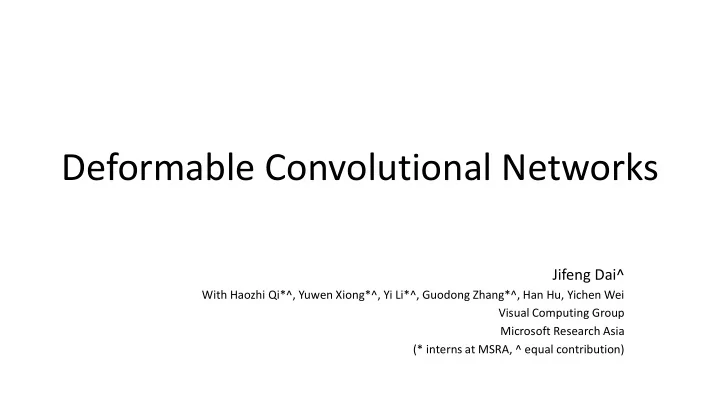

Deformable Convolutional Networks Jifeng Dai^ With Haozhi Qi*^, Yuwen Xiong*^, Yi Li*^, Guodong Zhang*^, Han Hu, Yichen Wei Visual Computing Group Microsoft Research Asia (* interns at MSRA, ^ equal contribution)
Highlights • Enabling effective modeling of spatial transformation in ConvNets • No additional supervision for learning spatial transformation • Significant accuracy improvements on sophisticated vision tasks Code is available at https://github.com/msracver/Deformable-ConvNets
Modeling Spatial Transformations • A long standing problem in computer vision Deformation: Scale: Viewpoint variation: Intra-class variation: (Some examples are taken from Li Fei- fei’s course CS223B, 2009-2010)
Traditional Approaches • 1) To build training datasets with sufficient desired variations • 2) To use transformation-invariant features and algorithms Scale Invariant Feature Transform (SIFT) Deformable Part-based Model (DPM) • Drawbacks: geometric transformations are assumed fixed and known, hand-crafted design of invariant features and algorithms
Spatial transformations in CNNs • Regular CNNs are inherently limited to model large unknown transformations • The limitation originates from the fixed geometric structures of CNN modules regular convolution 2 layers of regular convolution regular RoI Pooling
Spatial Transformer Networks • Learning a global, parametric transformation on feature maps • Prefixed transformation family, infeasible for complex vision tasks
Deformable Convolution • Local, dense, non-parametric transformation • Learning to deform the sampling locations in the convolution/RoI Pooling modules regular deformed scale & aspect ratio rotation
Deformable Convolution Regular convolution Deformable convolution where is generated by a sibling branch of regular convolution
Deformable RoI Pooling Regular RoI pooling Deformable RoI pooling where is generated by a sibling fc branch deformable RoI Pooling
Deformable ConvNets • Same input & output as the plain versions • Regular convolution -> deformable convolution • Regular RoI pooling -> deformable RoI pooling • End-to-end trainable without additional supervision
Sampling Locations of Deformable Convolution (a) standard convolution (b) deformable convolution
Part Offsets in Deformable RoI Pooling
Ablation Experiments on VOC & Cityscapes • Number of deformable convolutional layers (using ResNet-101) DeepLab Class-aware RPN Faster R-CNN (2fc) R-FCN # deformable layers mIoU@V (%) mIoU @C (%) mAP@0.5 (%) mAP@0.7 (%) mAP@0.5 (%) mAP@0.7 (%) mAP@0.5 (%) mAP@0.7 (%) None (0, baseline) 69.7 70.4 68.0 44.9 78.1 62.1 80.0 61.8 Res5c (1) 73.9 73.5 73.5 54.4 78.6 63.8 80.6 63.0 Res5b, c (2) 74.8 74.4 74.3 56.3 78.5 63.3 81.0 63.8 Res5a, b, c (3) (default) 75.2 75.2 74.5 57.2 78.6 63.3 81.4 64.7 Res5 & res4b22, b21, b20 (6) 74.8 75.1 74.6 57.7 78.7 64.0 81.5 65.4
Deformable ConvNets v.s. dilated convolution DeepLab Class-aware RPN Faster R-CNN R-FCN Deformable modules mIoU@V/@C mAP@0.5/@0.7 mAP@0.5/@0.7 mAP@0.5/@0.7 Dilated convolution (2, 2, 2) (default) 69.7 / 70.4 68.0 / 44.9 78.1 / 62.1 80.0 / 61.8 Dilated convolution (4, 4, 4) 73.1 / 71.9 72.8 / 53.1 78.6 / 63.1 80.5 / 63.0 Dilated convolution (6, 6, 6) 73.6 / 72.7 73.6 / 55.2 78.5 / 62.3 80.2 / 63.5 Dilated convolution (8, 8, 8) 73.2 / 72.4 73.2 / 55.1 77.8 / 61.8 80.3 / 63.2 Deformable convolution 75.3 / 75.2 74.5 / 57.2 78.6 / 63.3 81.4 / 64.7 Deformale RoI pooling N.A N.A 78.3 / 66.6 81.2 / 65.0 Deformale convolution & RoI pooling N.A N.A 79.3 / 66.9 82.6 / 68.5 regular convolution dilated convolution deformable convolution
Model Complexity and Runtime on VOC & Cityscapes • Deformable ConvNets v.s. regular ConvNets Method # params Net forward (sec) Runtime (sec) Regular DeepLab @Cityscapes 46.0M 0.610 0.650 Deformable DeepLab @Cityscapes 46.1 M 0.656 0.696 Regular DeepLab @VOC 46.0M 0.084 0.094 Deformable DeepLab @VOC 46.1 M 0.088 0.098 Regular Class-aware RPN 46.0 M 0.142 0.323 Deformable class-aware RPN 46.1 M 0.152 0.334 Regular Faster R-CNN (2fc) 58.3 M 0.147 0.190 Deformable Faster R-CNN (2fc) 59.9 M 0.192 0.234 Regular R-FCN 47.1 M 0.143 0.170 Deformable R-FCN 49.5 M 0.169 0.193
Object Detection on COCO • Deformable ConvNets v.s. regular ConvNets 48.5 FPN++ (ALIGNED-XCEPTION) 45.2 43.3 FPN+OHEM (ALIGNED-XCEPTION) 40.2 40.5 FPN+OHEM (RESNET-101) 37.4 37.5 R-FCN (ALIGNED-INCEPTION-RESNET) 34.5 35.7 R-FCN (RESNET-101) 32.1 35 FASTER R-CNN, 2FC (RESNET-101) 30.3 25.8 CLASS-AWARE RPN (RESNET-101) 23.2 20 25 30 35 40 45 50 mAP (%) Deformable Regular
Conclusion • Deformable ConvNets for dense spatial modeling • Simple, efficient, deep, and end-to-end • No additional supervision • Feasible and effective on sophisticated vision tasks for the first time
Recommend
More recommend